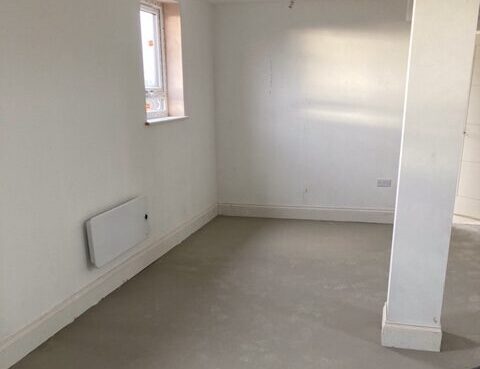Sticky Situations

In Sticky Situations, F. Ball technical representatives provide solutions to tricky flooring conundrums they encounter on site visits. In this issue, Gary Kenworthy provides a timesaving solution for preparing chipboard subfloors.
I was recently called to advise on a flooring installation as part of the conversion of offices into two-bedroom flats on the fourth and fifth floors of a relatively modern building in Greater Manchester. The majority of the subfloor, a total area of approximately 900m2, was P5 flooring grade chipboard, apart from a small concrete section of around 30m2 on the upper floor.
Luxury Vinyl Tiles (LVTs) were to be installed in the hallways, lounge, dining and kitchen areas of the properties; the bedrooms would be carpeted, while ceramic tiles would be installed in the bathrooms.
The Issues
It is usually necessary to overboard chipboard with flooring grade plywood prior to the standard procedure of priming the subfloor and applying a smoothing compound. Otherwise, a subsequently applied smoothing compound may detach from the subfloor, potentially resulting in floor failure.
The chipboard was higher than the concrete subfloors, so the level of the concrete would need to be raised where the two substrates met to ensure a consistent floor-level throughout. There were also a few minor cracks in the concrete, which was contaminated with paint elsewhere.
On the fifth floor, skylights meant the potential for high temperatures and temperature fluctuations resulting from solar gain. Over time, this could cause tenting in LVTs and gapping at the edges of floorcoverings as a result of their repeated expansion and contraction.
Timesaving Solution to Preparing Chipboard Subfloors
Technical advancements have enabled F. Ball to develop Stopgap Fill and Prime, a fast drying, cement-based primer that can be applied to flooring grade chipboard subfloors prior to the application of a recommended smoothing compound. It has a thixotropic consistency, meaning that it flows freely when stirred but sets to a gel-like consistency on standing, enabling it to fill gaps between panels to prevent imperfections transferring to the finished installation. This makes it ideal for use over raised access flooring. Once cured, the flexible nature of the product will also accommodate slight movement within the substrate.
Applying Stopgap Fill and Prime, rather than a general-purpose primer, over the chipboard removes the need to overboard the subfloor with plywood, saving valuable time and expense. It also meant that the flooring contractors were spared the task of carrying the plywood up four or five flights of stairs.
Prior Preparations
It would also be necessary to mechanically prepare the concrete screed to remove paint and other contaminants, which may inhibit the adhesion of subsequently applied subfloor preparation products, to leave a sound, clean, dust-free micro-textured surface. Cracks in the concrete would need to be vacuumed to remove any dust and debris before being repaired with F. Ball’s Stopgap 400 Repair compound. Flooring contractors would additionally need to ensure the chipboard was clean, dry and dust-free for the same reason.
It was recommended that the concrete subfloors were primed using Stopgap P131 general purpose primer, diluted with four parts water to one part primer, before applying F. Ball’s Stopgap 600 deep section compound at a minimum thickness of 5mm to raise the level of the floor to one level throughout. While most floor smoothing compounds can be applied at thicknesses up to 20mm, meaning at least two applications would have been required to build up the necessary thickness, Stopgap 600 Base is designed to be applied at thicknesses up to 50mm, allowing contractors to raise floor levels quickly and easily.
Once the chipboard was prepared with Stopgap Fill and Prime, it would be possible to apply Stopgap 1200 smoothing compound throughout the entire area, over both floors, to create a suitably smooth base for the installation of chosen floorcoverings.
Adhesive Recommendation for Installing LVTs
Finally, we recommended that LVTs were installed on the upper floor using a compatible temperature tolerant adhesive, such as F. Ball’s Styccobond F49 Hybrid PS, to enable the installation to withstand extreme temperatures and temperature fluctuations expected as a result of the skylights.
The solvent-free, water-based adhesive develops the ultra-high bond strength to hold floorcoverings firmly in place when exposed to temperature fluctuations from -20°C up to +60°C. The pressure sensitive characteristics of the adhesive, crucially high initial tack, would also help with the positioning and alignment of floorcoverings.
Gary Kenworthy is F. Ball technical representative for the North West.
F. Ball’s regional technical representatives provide advice to flooring contractors on how to get the most out of F. Ball products, including conducting site visits and producing case-specific reports advising on the best course of action for particular flooring projects. Find out who your technical representative is here.